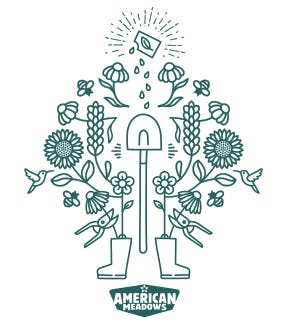Part Of The American Meadows Meadowscaping Learning Center
Wyoming Native Plants, State Flowers & State Bird
Native plants are adaptable, low-maintenance, and beautiful. They are the best choice for habitat-friendly gardens and thriving ecosystems. Find top picks for native plants in your state - and learn about your state bird and state flowers!
Follow Along With More Of Our Guides
Hello native plant enthusiasts! In the list below, you will find popular native plants and wildflower seeds, available from American Meadows, that have a native distribution in your state. You’ll also find information about your state bird, state flower, and state wildflower!
About Our Native Plant Lists For Each State
- The links will take you to a single plant or seed selection for the plant listed -- but in many cases, we offer multiple cultivars for each plant, and we may offer both seeds and potted plants to grow the plant on your list. This list is a work in progress as we expand our native plant educational resources.
- The list for your state is a great place for getting started with native plants - but it is by no means a comprehensive listing of the hundreds of native plants growing in each state.
Wyoming Native Plants
Grow our Native West Wildflower Seed Mix
Showy Goldenrod (Solidago speciosa)
Black Eyed Susan or Gloriosa Daisy (Rudbeckia hirta)
Yellow Prairie Coneflower (Ratibida columnifera)
Swamp Milkweed (Asclepias incarnata)
Long Beaked Sedge (Carex sprengelii)
Firewheel (Gaillardia pulchella)
Blanket Flower (Gaillardia aristata)
Wild Strawberry (Fragaria virginiana)
Plains Coreopsis (Coreopsis tinctoria)
Lanceleaf Coreopsis (Coreopsis lanceolata)
Wild Bergamot (Monarda fistulosa)
Elderberry (Sambucus canadensis)
Meadow Anemone (Anemone canadensis)
Anise Hyssop (Agastache foeniculum)
Big Bluestem (Andropogon gerardii)
Little Bluestem (Schizachyrium scoparium)
Tufted Hair Grass (Deschampsia cespitosa)
Yellow Prairie Grass (Sorghastrum nutans)
Aromatic Aster (Symphyotrichum oblongifolium)
New England Aster (Symphyotrichum novae-angliae)
Wyoming State Bird, State Flower & State Wildflower

Western Meadowlark ~ Sturnella neglecta
In plumage there is little to distinguish the Western Meadowlark from his eastern counterpart. Both have streaked upper parts, a yellow breast with a black V, and white outer tail feathers. The Westerner, however, is somewhat paler. In the realm of song, all resemblance ceases. Unlike the Easterner’s plaintive, whistled song; the Western Meadowlark’s phrases contain hints of the wood thrush, the Baltimore oriole, and the bobolink.
Indian Paintbrush ~ Castilleja linariaefolia
The Indian paintbrush is one of a group of plants that seem, at first glance, to bear bright flowers, but a closer look shows that appearances are sometimes deceiving. Actually, the tubular creamy flowers, about one inch in length, are almost hidden by the sepals, which are tipped with orange-red, and the light-red bracts, which are one-to-two inches long. The real leaves are green. They, and the rest of the plant, are covered with short fine hairs. This member of the figwort family grows to about two feet in height, and near the ground, it divides into several stalks which in turn have little branches. The plant resembles a paintbrush.
From The Wildflowers of the 50 States U.S. stamps issued July 24, 1992:

About Native Plants
- Native plants are essential for healthy ecosystems and habitat. They have evolved over time with local wildlife and climate conditions. Many pollinators have special relationships with native plants that they rely on for survival. For instance, some bees are specialists and require nectar and pollen from specific native plants to survive; and butterflies and moths often have specific host plants needed to nourish their caterpillars. For example, Asclepias (Milkweed or Butterfly Weed) is the host plant required for Monarch caterpillars to survive and grow into Monarch Butterflies!
- It’s OK to grow native plants in your yard that may not be native to your state or region. Remember – just because a plant is not native, does not necessarily mean that it is invasive or harmful. In fact, growing well-behaved introduced plants that are suited to your growing conditions can still provide many benefits to your yard (especially when compared to a traditional turf lawn).
- Know before you grow – It's always a good idea to learn what plants are native, well-behaved, and invasive or aggressive in your region before digging in.
- Learn More: All About Native Plants
Explore our full selection of native plants and seeds
More From Our Learning Center

